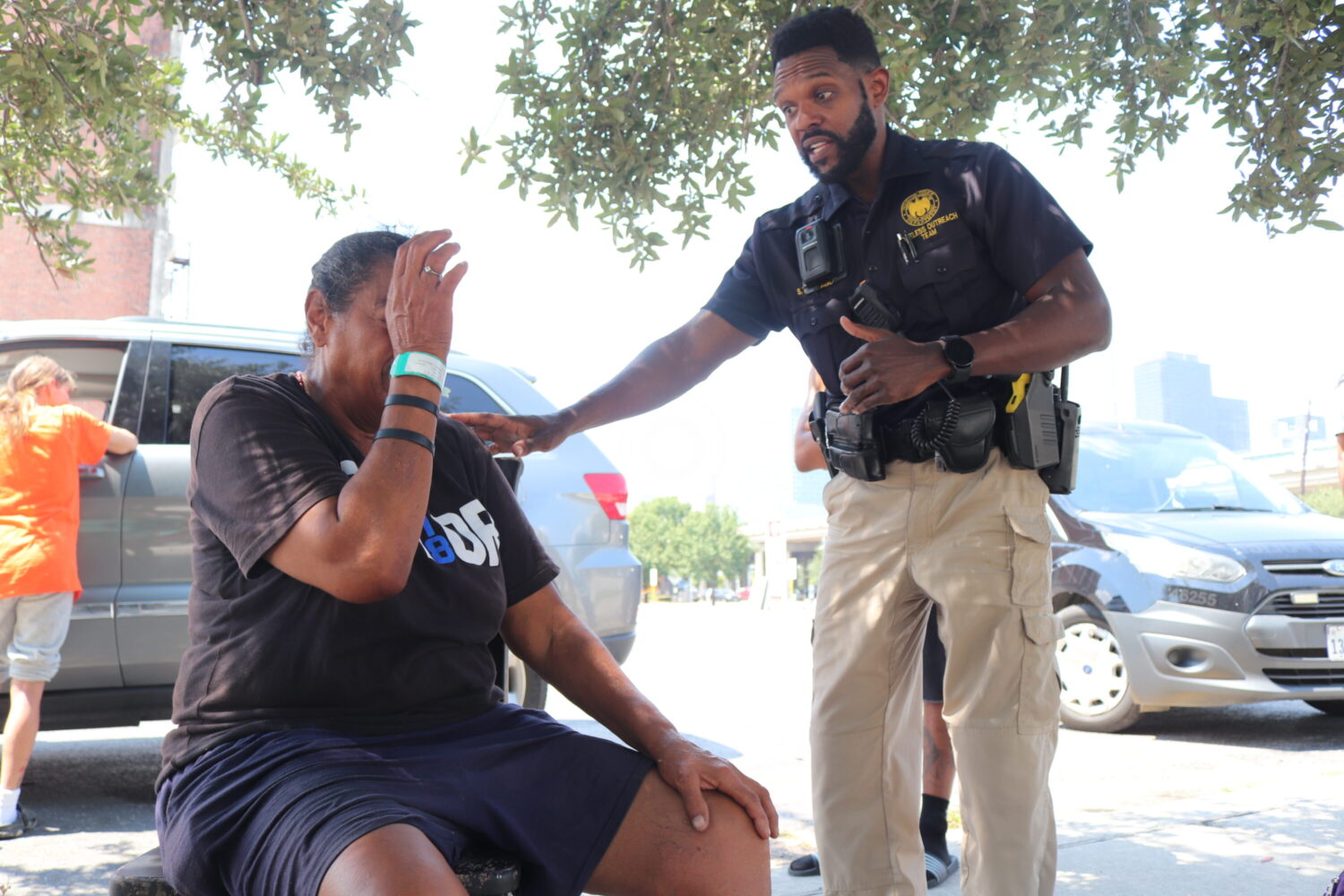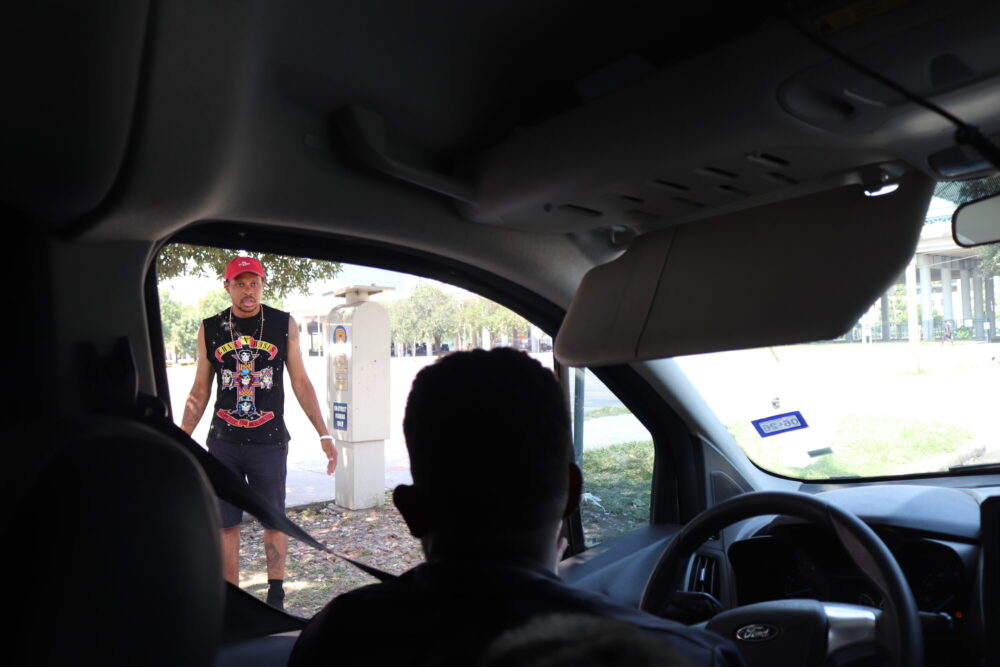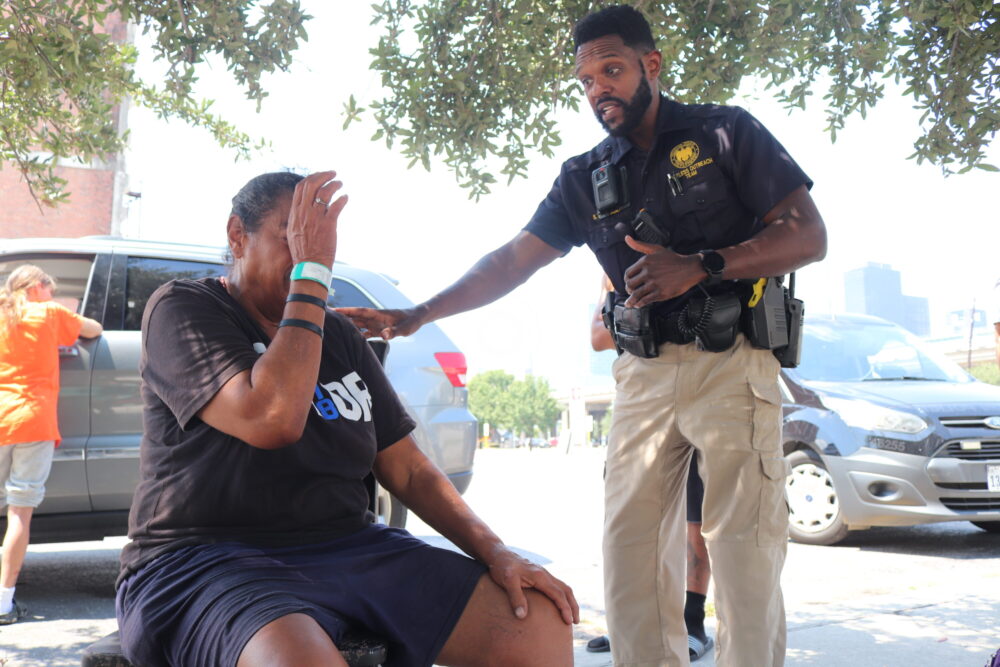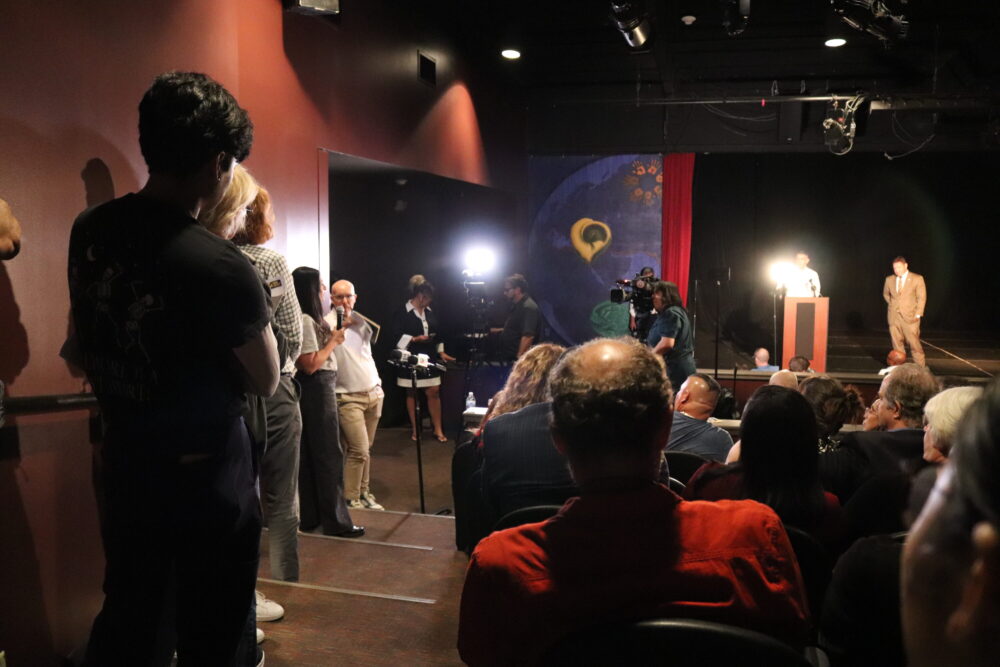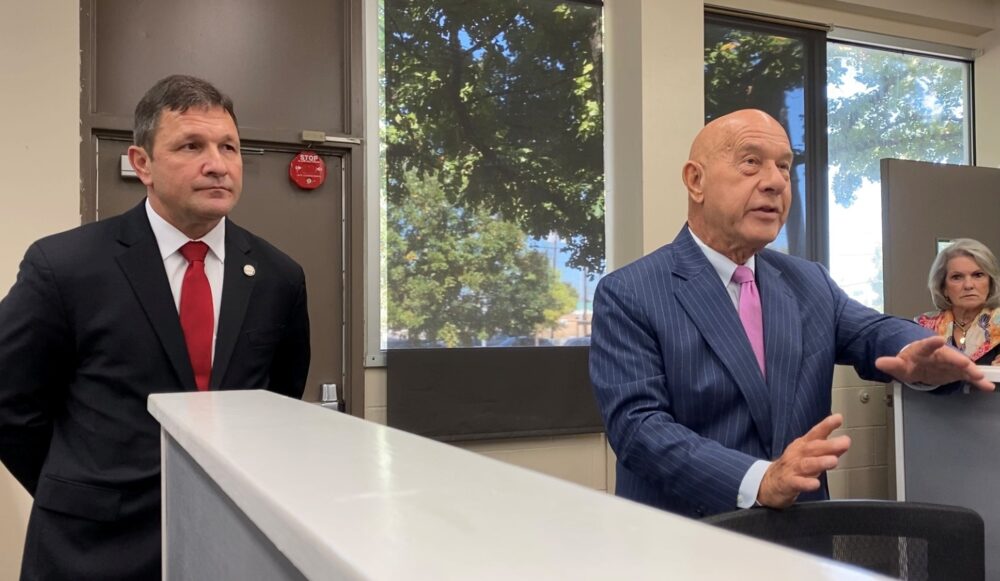Dominic Anthony Walsh/Houston Public Media
Houston Police Department officer Sheldon Theragood, foreground, speaks to John Pedroza in August 2025.
Next to a parking lot in Houston’s East Downtown in late August, Houston Police Department officer Sheldon Theragood checked on the housing waitlist for John Pedroza, who had been homeless for about a week at that point.
It’s a typical task for Theragood — not enforcing city ordinances and state laws, but interacting with homeless people across the city. He’s a member of the police department’s Homeless Outreach Team (HOT).
There was good news for Pedroza — he was on the list. But also bad news — he didn’t have an ID or social security card.
“So everything is good right now, so we just gotta wait, but in the meantime, while you’re on the waitlist, we gotta get your documents,” Theragood said. “Other than that, how are we doing?”
Click here for more inDepth features.
“I’m doing alright,” Pedroza responded. “I’m just trying to get off the streets.”
Theragood and his partner left their air-conditioned van to work with the half-dozen other homeless people in the parking lot. In a brief interview with Houston Public Media, Pedroza said he was recently released from prison at the age of 43 after serving 24 years — nearly his entire adult life.
Pedroza said his journey to the streets started early.
“You know how so many people are when they’re in their teenage years — they’re just young and wild,” he said.
Drugs exacerbated mental health challenges. He said he was trying to stay sober — but was stuck in limbo.
Frustrated by a delay in getting his social security card, Pedroza was kicked out of a transitional group home after causing a disruption. He said in August he had been in and out of shelters.
“I’m just basically, just trying to see if I could get into the next shelter that’ll take me,” he said. “Get off the streets. Stay on my meds. Stay off the drugs, and stay off the streets.”
For people like Pedroza, it could soon be easier to get off the streets.
Dominic Anthony Walsh/Houston Public Media
Brigitt Walker, left, who has been homeless for seven years, speaks with a Houston Police Department officer.
Houston Mayor John Whitmire is pushing the city council to approve the purchase of a $16 million facility at 419 Emancipation Ave. — just blocks away from where Pedroza waited in August. With three beds and space for a fourth in each of its 80 rooms, the facility could temporarily shelter up to 320 people at a time. The administration pitched it as a low-barrier living center, serving the most vulnerable people who have challenges finding shelter elsewhere.
Theragood’s routine could also change. Whitmire said the HOT squad will be expanded and based out of the facility in an effort to address the neighborhood’s public safety concerns.
City officials frame the facility as a key part of their multipronged initiative to functionally end street homelessness before 2027 — but it’s faced fierce resistance over the past few weeks from nearby residents.
Neighborhood residents fight back
After Whitmire’s administration unveiled the planned facility earlier this month, proposing to purchase the building for $16 million, the backlash was swift.
The purchase was delayed twice over the past two weeks, once by the administration and again by council member Mario Castillo — who heard from residents at a community meeting on Thursday.
“If somebody kills my grandma, is the city going to pay for her stuff? Are they going to be held accountable because they wanted this facility here?” Israel Silva asked, adding, “Keep them people away from me.”
He wondered why more affluent neighborhoods to the west weren’t considered.
“Move it to River Oaks. Move it to the Heights. You think we’re freaking out? ¡Chale! You see them,” he yelled to raucous laughter from the crowd.
Residents of Second Ward and East Downtown raised concerns about home values, crime, quality of life and the unpleasant sight of people living on the streets.
Speaking directly to community members at a city council meeting before the second delay, Whitmire argued their fears were misinformed — and the facility will actually improve the neighborhood.
Dominic Anthony Walsh/Houston Public Media
Houston residents gather for an East Downtown community meeting on Thursday, Oct. 23, 2025, to discuss a proposed living center for the homeless.
“If we do nothing, they’ll be on the streets,” Whitmire said. “We’re not going to allow them to be on the sidewalk, laying around the way they’ve been for years and years. This is to get them back, productive, and the only way you can get them off the street and out of your neighborhood is get them in a residential setting where you can work with them.”
He said HPD patrols will be increased in the area — and the nine-person HOT team, including Theragood, would move its office to the facility while also expanding.
Andrew Sullivan, assistant professor with the University of Central Florida’s School of Public Administration, has researched neighborhood concerns about homeless shelters and services across the country. The type of negative reaction seen in Houston’s East Downtown is “extremely common,” he said.
“I think it would probably be the exception if something opened without any types of protest or resistance or even just like community meetings saying, ‘We maybe don’t want this here,'” Sullivan said.
His research found that one of the most common concerns, dropping home values, was unfounded. In fact, home values near service providers increased over time.
He said that could be because of the simple difference between a homeless person on the street versus a homeless person in a shelter.
“There’s this distinction between visible and invisible homelessness, and so the person you see on the street corner asking for money … that might be what they picture as homelessness, or the typical cases of it,” he said, adding that most homeless people actually live in shelters, getting services — when they’re available. “Someone just driving by down the street maybe would never notice them. … This would be consistent with that idea, too, is that service provision also helps people get services, get help, get housed.”
A key part of Whitmire’s multipronged initiative
According to the annual count in January by the Coalition for the Homeless and its partners, about 1,800 of the 3,000 homeless people in Harris County lived in shelters during the tally in January. Without enough beds in the shelter system, another 1,200 slept on the streets — many in the central urban core, where the proposed living center would open.
On the sidewalks of East Downtown, Pedroza joined that population in August.
At the time, he was violating a newly expanded city ordinance. It’s now illegal to sit, lay or place personal possessions on sidewalks in downtown and East Downtown during all hours of the day — an expansion of existing rules as part of Whitmire’s multipronged approach to address street homelessness.
RELATED: Houston ramps up citations of homeless after July civility ordinance expansion
The city’s rules clashed with Pedroza’s reality.
“I mean, there’s nowhere for me to go. There’s nowhere for me to sleep,” Pedroza said. “Until I can get a shelter to accept me … I’m just stuck out here on the streets, sleeping on the streets, doing whatever I can to survive out here.”
Sarah Grunau/Houston Public Media
Houston Mayor John Whitmire, right, speaks during a tour of a proposed homeless resource facility at 419 Emancipation Ave. on Monday, Oct. 20, 2025. At left is Larry Satterwhite, the mayor’s director of public safety and homeless security.
Whitmire’s administration is aware of the tension, according to the mayor’s director of public safety and homeland security, Larry Satterwhite.
“We need a bed,” Satterwhite said. “The idea is, if we are saying that, ‘I’m sorry, sir, ma’am, you can’t do this anymore’ or ‘You can’t be here’ … we need a place that they can be because otherwise we’re just moving them to the next problem in somebody else’s neighborhood.”
That’s the idea of the proposed homeless living center. It would be a six-block walk from where Pedroza was waiting. He spoke to Houston Public Media before plans for the new homeless living center were unveiled — but it was exactly what he was looking for.
“I’m basically just trying to get off the streets,” he said. “I don’t want to spend the rest of my life out here. I mean, nobody wants to spend the rest of their life out here.”
If the city council approves the $16 million purchase on Wednesday, the center is slated to open in early 2026. The proposed facility is expected to serve more than 1,000 people per year — better positioning Whitmire’s administration to ensure everyone is provided housing within 90 days of becoming homeless, which officials define as functionally ending street homelessness, by the end of next year.
